This is the essence of a report I wrote up for one of my customers, with recommendations on what to do about Atlassian's move to Cloud. |
I make this available because a lot of companies are having to evaluate the alternatives right now, and may benefit from seeing a worked example that includes short-term discounts. This company is on 2000-user Jira and Confluence, and interacts with their customers through Jira, so some of the considerations, like splitting off a separate JSD, won't apply to non-public Jiras.
If you spot any factual errors or flaws in my logic, please let me know. I regret I cannot make available the spreadsheet the numbers are based on because it contains a Partners-only pricing table. Please contact me if you'd like a similar analysis done for your business.
Dear $CLIENT,
Atlassian are discontinuing their 'Server' (self-hosted) product line in favor of the Cloud alternatives. This affects us, as we are using both Jira Server and Confluence Server.
Atlassian's timeline is:
Atlassian is pushing the majority of customers to Cloud. The 'Data Center' (DC) product line, a clustered edition for large instances, will still be available, but its price will be increasing by 15-180%.
We will consider
We paid $17,500 in 2020 to renew Jira license. Jira's license expires in July 2021.
We paid $13,100 in 2020 to renew Confluence. Confluence's license expires in Feb 2021.
Both these prices were artificially low, as we are on an 'advantaged' (grandfathered) plan that escaped the 2019 price increases (non-grandfathered renewal costs were $30,000 and $22,500 for Jira and Confluence respectively).
Plugins are not considered here as their costs are dwarfed by the base costs, but increases moving to Cloud can be assumed (e.g. 20% for Tempo Timesheets, 600% for JETI).
The three options Atlassian make available to us are:
Here are the anticipated prices for each option, taking into account projected user count growth and various short-term discounts. There are two DC columns because the price for DC will be different (for a while) if we act before Feb 1, 2021 and get on a 'grandfathered' / advantaged plan to escape the 15-180% price hike coming then.

Our base spend (Jira + Confluence) will thus increase 10x or 11x from its current $30,600
As an Atlassian product consultant I am very unimpressed with Atlassian's move. I have written up my (sanitized) thoughts on this move on my website. I have also put up a website for exploring alternatives products, for users for whom a 10-11x price increase is infeasible:
In that context, what would I recommend?
The least disruptive move would be to move to Data Center, assuming we can afford it (the 'DC, after Feb 1, 2021' column). Moving early will lock in some discounts. Just be aware that DC is an annual subscription, not a perpetual license like Server, and that DC won't last forever (see blog post Betting on Atlassian DataCenter?). As happened with Server, DC is likely to undergo constant price increases to 'squeeze' larger customers onto Cloud.
If we don't want to jump to DC or Cloud just yet, my suggestion is lock down Jira and wait for better alternatives. There are no good options now, we have no pressing need to move, so let's just batten down the hatches, save some money and see what alternatives emerge.
This "lock down and wait" approach can be realised in 4 steps:
One more upgrade buys us license slot headroom beyond 2022:
Do not pay for further Server renewals. Atlassian haven't added any serious feature improvements in years, and certainly won't do so now. Bug fixes are nice, but after 18 years of development there aren't many bugs left that affect us and that Atlassian are willing to fix. Atlassian support on its own isn't worth paying for.
On the other hand, we do need ongoing security patches if we are to run a public-facing instance. Which is why:
Implement a new public-facing system for customer support. Perhaps Jira Service Desk (JSD) Cloud where non-agents are free, or ServiceNow.
If we break our Jira active users into employees and customers, we see that employees are growing linearly, whereas customer accounts are increasing non-linearly:
| Employee Jira Users | Customers |
|---|---|
|
|
Moving customer support to JSD Cloud means that non-linear growth isn't a problem: we don't pay for customers, only for 'agents'. Moving our customers to a Cloud product should be a net win for security.
Jira averages about 1 'critical' security vulnerability every 6 months (generally a CSRF). If we stop paying Atlassian maintenance fees, or run Jira beyond 2024, we need to mitigate security vulnerabilities ourselves, which we can only realistically do by locking down Jira. Either:
We could further lock down Jira by adding a WAF like mod_security or Cloudflare, so that security vulnerabilities we learn of can be mitigated at the HTTP layer.
With customers out of the picture and Jira locked down to employees, we can take our time evaluating Jira Server alternatives.
Realistically, Jira Cloud might still end up being our best option. Even if that turns out to be the case, I'd argue that waiting a few years can only benefit us. Today Jira Cloud is an immature, over-priced product, with poor performance, a weak plugin ecosystem and unclear GDPR compliance prospects. Many ecosystem vendors (notably Tempo) are still scrambling to sort out their Server-to-Cloud migration pathways. Yet Atlassian are betting hard on Cloud, and in 5 years' time Jira Cloud will be much more compelling, and the migration process much smoother.
Also, in 5 years time there may be decent competitors. I've been impressed with https://wiki.js.org and xwiki.org as Confluence alternatives. Good Jira alternatives are much scarcer, but there is Youtrack, Gitlab and a host of SaaSes (Asana, Clubhouse). Even Request Tracker is looking less 90s these days and may be an option. I and others will be keeping tabs on alternatives via https://www.goodbyeserver.org/
We now show how the numbers above are derived. Note: the primary source of calculations is a spreadsheet, which I unfortunately cannot publish due to containing Partners-only information:
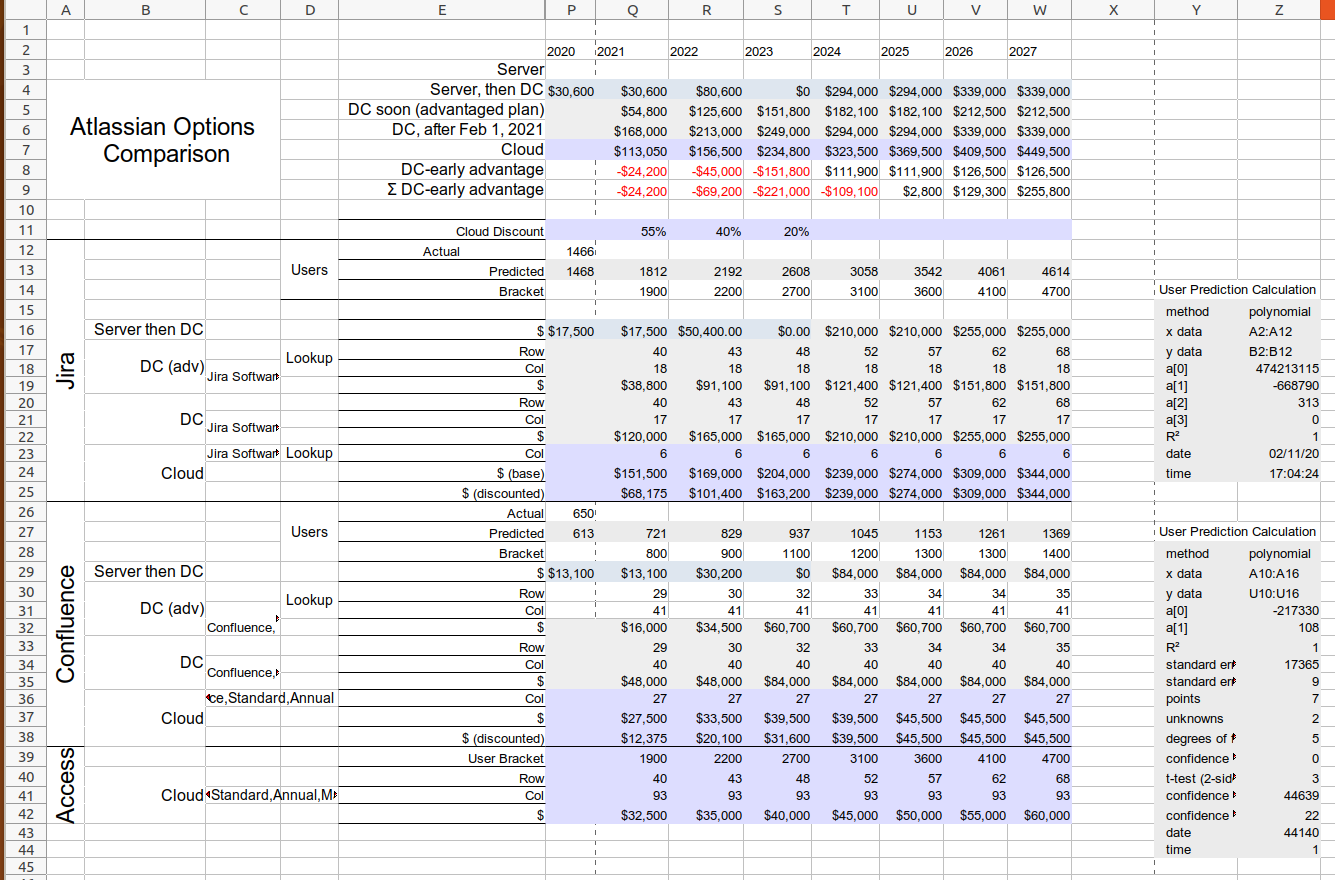
Before considering costs, we need to know how many users we expect to cater for in future.
| Jira | Confluence | |
|---|---|---|
Jira has a 2000 User license, with 1463 license slots used as of . License use is increasing each year (despite automatic deactivation after 6 months' inactivity). 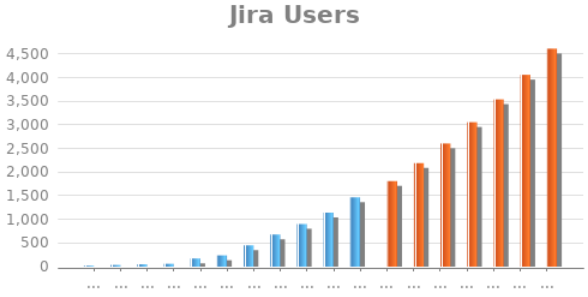 This shows that if current growth continues we will hit our 2000-user license limit in early-2022, and will be forced into Jira's next user tier, 10,000 users.
| Confluence is also on a 2000 user license, with 650 license slots used as of . Growth appears linear. No 'deactivate inactive user' process is being run yet. 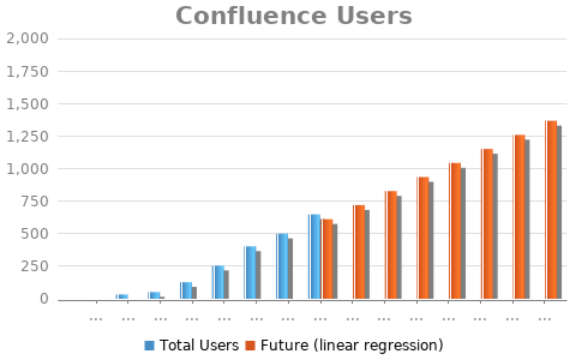 |
We are on 'advantaged' plans, and we know price increases are coming for 'advantaged' plans on 2/Feb/2021.
Jira's natural renewal date would be Jul 4, 2021, and Confluence's would be Feb 2021.
But, but renewing early before the price increase, we can save a bit of money. This is "Option 3: Renew on server early and lock in your existing price".
So prior to Feb 2, 2021 we should:
Confluence will be due for renewal in Feb 2022, and Jira in Jul, 2022.
However! Atlassian plan to stop selling license upgrades after Feb 2, 2022 and we know we'll need an upgrade to 10,000 users in this year. If we wait till Jul 4, 2022 to upgrade Jira we'll be stuck on the 2000-user license tier forever.
So once again we must jump in early:
"How long can I lock in my current pricing" FAQ in the Billing & licensing questions section of the Future server pricing page, it should be possible to renew for 24 months:

So both our Jira 10,000 user license and Confluence 2,000 user license will last 24 months, from Jan 2022 till Jan 2024.
As for pricing, our 'advantaged' status will have ended on Feb 2, 2021, so the 'New price for advantaged plans' prices from the Future server pricing tables page applies:
| Jira | Confluence |
|---|---|
|
|
The costs in Jan 2022 would thus be:
No costs, as we paid for this year in advance.
After 2/Feb/2024 all support ends, and we'd have to purchase Data Center licenses annually, at the 'New Atlassian list price' from the future DC pricing tables:
| Jira | Confluence |
|---|---|
|
|
For Jira this means $210,000+. For Confluence it means $84,000+.
The total costs of staying with Server as long as possible will be:
| 2021 | 2022 | 2023 | 2024 | 2025 | |
|---|---|---|---|---|---|
| Jira | $17,500 | $50,400 | $0 | $210,000 (assuming 3001-4000 user bracket) | $210,000 (assuming 3001-4000 user bracket) |
| Confluence | $13,100 | $30,200 | $0 | $84,000 (assuming 1001-2000 user bracket) | $84,000 (assuming 1001-2000 user bracket) |
The cost from 2021-2023 is $111,200 (17500+50400+13100+30200) and $294,000 (210000+84000) per year thereafter (while under 4000 users).
If we upgrade our licenses to Data Center before 2/Feb/2021, then:
| Jira | Confluence |
|---|---|
|
|
So prices would be:
| 2021 | 2022 | 2023 | 2024 | 2025 | 2026 | 2027 | |
|---|---|---|---|---|---|---|---|
| Jira | $38,800 ($52,800, the current price of 2000-user DC, less crossgrade discount of $14,000) | $91,100 assuming 2000-3000 users | $91,100 assuming 2000-3000 users | $121,400 assuming 3001-4000 users | $121,400 assuming 3001-4000 users | $151,800 assuming 4001-5000 users | $151,800 assuming 4001-5000 users |
| Confluence | $16,000 ($30,000 current 1001-2000 user DC license of less crossgrade discount of $10,480) | $34,500 assuming 501-1000 users | $60,700 assuming 1001-2000 users | $60,700 assuming 1001-2000 users | $60,700 assuming 1001-2000 users | $60,700 assuming 1001-2000 users | $60,700 assuming 1001-2000 users |
| 2021-2023 | 2024 | 2025 | 2026 | |
|---|---|---|---|---|
| Option 1: Server-then-DC | $111,200 (17500+50400+13100+30200) | $294,000 (210000+84000) | $294,000 (210000+84000) | $294,000 (210000+84000) |
| Option 2: DC now | $332,200 (38000+91100+91100+16000+34500+60700) | $182,100 (121400+60700) | $182,100 (121400+60700) | $212,500.00 (151800+60700) |
| DC-now cost saving | -221,000 | $111,900 | $111,900 | $81,502.00 |
So while moving to DC now will costs $221,000 more over 3 years, each subsequent year we save money, breaking even in 2025, and saving $81,502 in 2026 and beyond.
Will Atlassian keep us 'advantaged' till at least 2025? Atlassian's stated goal with the 'advantaged' tier is to "ease users into list prices over time". I have questioned how long the easing process will go for, but have received no reply. As bets go, betting that Atlassian will keep our license status 'advantaged' for 5 years seems reasonable.
Atlassian have 4 tiers in their Cloud products: Free, Standard, Premium and Enterprise:
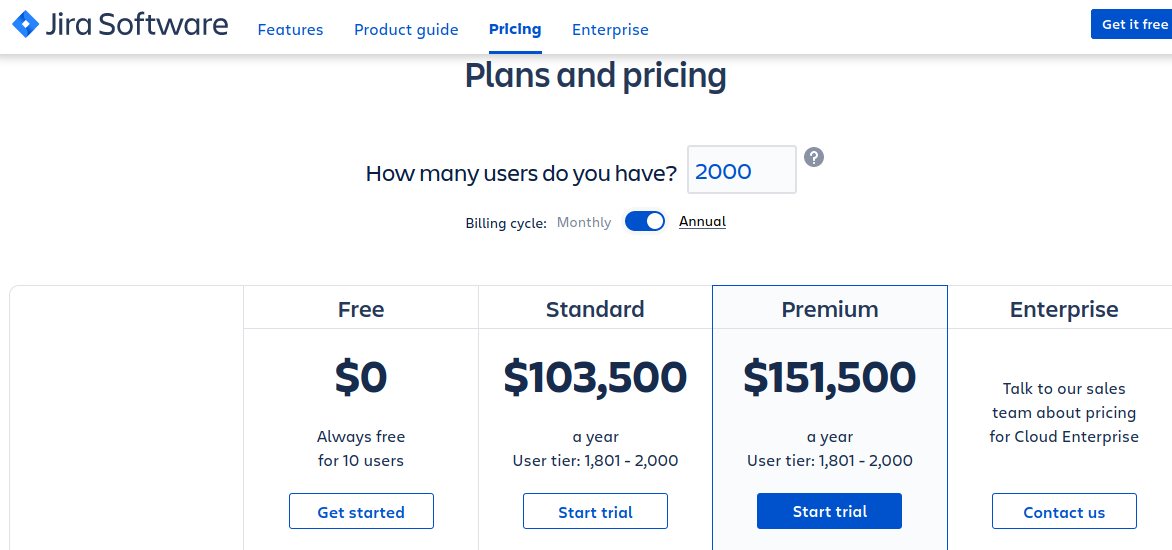
The differences between tiers are seen in the business end of the feature table:
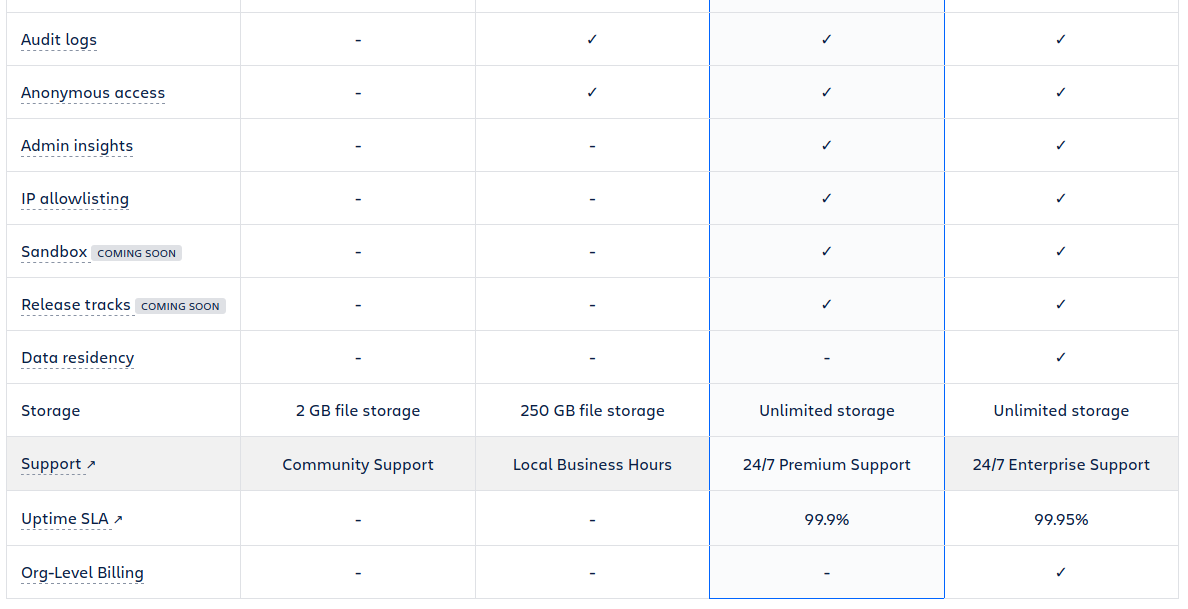
The first question to address is whether Jira and Confluence need to comply with GDPR regulations. If so, the only 'tier' of Cloud that could work is Enterprise, which offers 'Data residency'. Even with Enterprise, GDPR compliance is doubtful, as the Standard Contractual Clauses Atlassian depend on may soon be invalidated for the same reasons the EU-US-Privacy Shield was invalidated in July. Someone more versed in our GDPR needs and GDPR in general will need to make a call here.
As noted above, Jira uses 413Gb of disk space, over the 250Gb limit for Cloud 'Standard', so we'd need a 'Premium' Cloud subscription.
Atlassian Access is Atlassian's centralized user database for Cloud. It is required if we wish to sync with existing LDAP. Access also provides 2FA, SSO, SAML and other advantages.
Cloud pricing can be obtained from Atlassian's Cloud pricing calculator for Jira and Confluence. There is no equivalent pricing table that I can find (the Future cloud pricing tables 'New Price New License' column would apply, but there is no table for Cloud Premium). It is best to pick 'Annual' billing cycle, as this works out cheaper per year and also is required for 'loyalty discounts' (more on them below).
Atlassian is offering a Cloud loyalty discount for users migrating from Server or DC to Cloud. The discount schedule is:
thereafter full price.
So our yearly pricing with Cloud would be:
| Year | Discount | Jira Tier | Jira Base Cost | Jira Cost | Confluence Tier | Confluence Base | Confluence Cost | Access Cost | Total |
|---|---|---|---|---|---|---|---|---|---|
| 2021 | 55% | 1801-2000 | $151,500 | $68,175 | 601-800 | $27,500 | $12,375 | $32,500 | $113,050 |
| 2022 | 40% | 2001-2250 | $169,000 | $101,400 | 801-1000 | $33,500 | $20,100 | $35,000 | $156,500 |
| 2023 | 20% | 2501-2750 | $204,000 | $163,200 | 1001-1200 | $39,500 | $31,600 | $40,000 | $234,800 |
| 2024 | 3001-3250 | $239,000 | $239,000 | 1001-1200 | $39,500 | $39,500 | $45,000 | $323,500 | |
| 2025 | 3501-3750 | $274,000 | $274,000 | 1201-1400 | $45,500 | $45,500 | $50,000 | $369,500 | |
| 2026 | 4001-4250 | $309,000 | $309,000 | 1201-1400 | $45,500 | $45,500 | $50,000 | $404,500 | |
| 2027 | 4501-4700 | $344,000 | $344,000 | 1201-1400 | $45,500 | $45,500 | $60,000 | $449,500 |
(Note: figures are from Atlassian's spreadsheet. Prices for Access diverge slightly from the website)
Please see the summary at the beginning for comparison of these three options, and my recommendations.